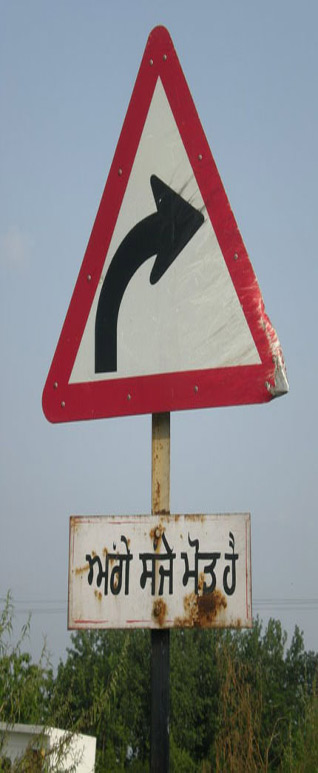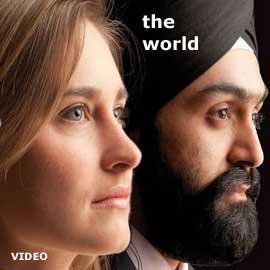Current Events
The Punjabi Language In Canada
SADHU SINGH BINNING
There is much that needs to be done for the preservation and development of the Punjabi language in Canada. In my view, currently, it is a crucial time for the Punjabi community to work towards creating a brighter future for our language in Canada. This moment shall also pass all too quickly, without a care as to whether it was used wisely or not.
Canada is recognized as an exemplary multicultural country. All cultures are equally accepted and respected here. However, the biggest drawback of Canadian multicultural structure is the lack of recognition of other languages.
It is a known fact that no culture can survive without its language. Yet, at the federal level, only two languages are recognized as official languages of Canada.
As any country is at any given time, Canada is a project in the making.
Once upon a time the French language faced a tough battle in attaining its due recognition in Canada. Moreover, until recently, very little attention was paid to the aboriginal languages and they too are struggling to stay alive. During the mid-twentieth century, other European languages such as Ukrainian and Italian were unsuccessful in their efforts to win their place as Canadian languages. In fact, Canada became a multicultural country in response to their demands but it did not become a multi-lingual country. Over time, the number of speakers for these languages declined and now they are no longer in a position to make such demands.
At this moment the coincidental position of Punjabi in Canada is such that the Punjabi community can make an effort to advocate some reasonable changes to Canada’s language policy. This will be a step in the right direction not only for the Punjabi language but for other minority languages as well. This is a historical moment for the Punjabi language but it will not remain so for long.
Here are some facts:
1 Punjabi has been spoken in Canada since 1897. However, until the early years of the 1980s, the Punjabi community and its language existed completely on the margins of mainstream society. Due to an increase in numbers and positive changes in Canadian society, the position of the Punjabi community has improved greatly but as far as language is concerned it is still on the margins.
In the 2011 census Punjabi became the third largest spoken language in Canada following English and French.
2 In last year’s federal election, more than 20 people from the Punjabi community were elected as part of Justin Trudeau’s Liberal government. As a result, Punjabi has coincidentally become the third most represented language in the present parliament, and a number of key federal ministries have been given to members from the Punjabi community.
However, these facts on their own will not have any effect on the situation of the Punjabi language.
3 Currently, a majority of the people within the Punjabi community are from the immigrant generation and they are using the language not only in their daily personal communication but also in their workplaces, businesses and in the media. Those born in Canada are also learning and using the language, especially in large centres like Vancouver and Toronto. It is important to recognize this situation now because it will likely not be the case 20 years into the future.
4 The development in the Punjabi media during the last three to four decades is simply mind-boggling. In every Canadian city with a sizable Punjabi community such as Vancouver, Toronto, Calgary, Edmonton and a few other places, there are dozens of Punjabi newspapers. A number of glossy magazines which are comparable to mainstream English magazines, are also published regularly. They include the Punjabi Gurmukhi script to advertise jewellery, clothing and other commercial items.
These publications are a great achievement for the Punjabi language, not only on a national level but internationally as well. In some ways, even more remarkable than the print media is the use of Punjabi in radio and television. In each city there are a number of local radio stations that are owned by Punjabis themselves and offer 24-hour Punjabi programs. Some cities also have local daily television shows while numerous programs are aired across the nation on Saturdays.
5 The Sikhs are a majority in the Punjabi community of Canada. Their relationship to the Punjabi language differs from the Muslim and Hindu Punjabis. For example, almost every Gurdwara makes a special effort to teach the Punjabi language to the younger generation. This is not the case with local Hindu temples or Muslim mosques where Punjabis form the majority of the membership.
6 There is a vibrant community of Punjabi writers in each city. These creative individuals have published hundreds of titles in various genres during the last 30 years. A prestigious annual award for the best work of fiction in Punjabi has been established in Vancouver to recognize the vibrant literary community in the world.
* * * * *
In my view, these are only some of the facts that place Punjabis in Canada in a suitable position to try and affect some changes to the language policy at the federal level.
It is important to mention briefly that the need of the time is to have a language policy that reflects the present demographics of the country. Undoubtedly, that is a tall order and may be a lengthy process.
The second suggestion could be that a formula should be created that recognizes languages according to their population and length of existence in Canada.
As I have said, the present position of Punjabi will not last forever. The current Punjabi political representation could change, as can laws and policies; therefore, it is not a given that immigration of Punjabis will keep on increasing. The next generations of Punjabis will not have the same relationship with Punjabi.
The businesses that are at this time supporting Punjabi media will eventually start to sell their products by using mainstream media. This, in turn, will directly impact the progression of Punjabi media. Although no one can predict what will happen in the future, the important thing to think about is what can be done with the current opportunities that can have a positive impact on the future of the Punjabi language.
As Canadians, we are very proud of the fact that ours is a fair and just society. This was created by fair-minded people who have journeyed far from a society that forced the Komagata Maru out of Burrard Inlet a hundred years ago.
There is no doubt that some people may feel that they have lost their privileged position in society, but by treating all citizens equally Canada has become a better place for all to live.
Similarly, if other languages are given due recognition this would certainly make Canada a much richer and more inclusive place for all.
We should recognize the fact that politicians do not and cannot take on issues like these on their own. The responsibility lies with the Punjabi community who need to express their desire to see their mother tongue flourish in Canada.
The time to act is now.
[Courtesy: Voice. Edited for sikhchic.com]
February 26, 2016
Conversation about this article
1: Pritpal Kaur (London, United Kingdom), February 26, 2016, 9:08 AM.
I must say I love the way you at sikhchic.com choose and place your illustrations and graphics. You have shown over and over again how indeed a picture speaks a thousand words. Look above: the image of the 'Yield' Sign encapsulates the entire thrust of the article. The caption in Punjabi reads: "aggey sajjey morrh hai". 'Right turn ahead.' The emphasis, of course, is that we need to take a new direction shortly. However, the word 'morrh', at a quick glance, seems to read 'maut' (death) because the rust on the sign seems to have obliterated the bottom part of a letter. Genius, in your choice of this photo, as is. It reminds us: what lies ahead is a choice, an urgent need for change, or else, death could be waiting around the corner! Literally or metaphorically. Thank you for the reminder!
2: Harinder Singh (Punjab), February 26, 2016, 10:47 AM.
Punjabi Language needs to flourish and grow across this planet. 1) We need to set up in schools, colleges and universities the teaching of Punjabi courses all over the world. 2) Punjabi language should function as the medium in all spheres of our lives ... from Music, Movies, Science, Technologies, Law, News, Internet, etc. 3) Language experts need to add new words and enhance the grammar of the language. 4) All books and movies made in the world need to be translated into the Punjabi Language.
3: Sangat Singh (Kuala Lumpur, Malaysia), February 26, 2016, 8:17 PM.
I remember a hilarious sign in Kashmir a long time ago which warned the motorist of a very narrow pass with a deep valley. It read: "Please be careful but should you miss and roll down, don't forget to look at the right side, the scenery is just too beautiful". Glad that Sikh-Canadians have preserved their sense of humour.
4: Roop Dhillon (London, United Kingdom), March 01, 2016, 7:00 PM.
I just wish we had this much dedication in the UK. Those who call themselves Punjabi writers are insular and navel gazing ... the rest don't know how to use it for anything other than Bhangra songs ... even though that too is dying out.



